Estimating the Impact of a Recuperative Approach on the Efficiency of Thermoelectric Cooling
Abstract
1. Introduction
- Identification of the possibilities and limitations of the recuperative cooling approach and a proposal of three metrics to describe its impact and usefulness:
- a.
- Relative amount of recuperated electrical energy;
- b.
- Relative amount of additional heat losses due to recuperation process;
- c.
- Figure of recuperation implementation rationality.
- Development of an analytical model using the thermal–electrical analogy method to estimate the proposed metrics at different operating conditions.
- Development of experimental method to validate the proposed model and assess the suggested metrics.
2. Materials and Methods
2.1. Theoretical Analysis
- Thermoelectric element figure of merit ;
- Electrical resistance of the thermoelectric element and electrical load resistance ;
- Time spent in cooling and recuperation modes relative to the thermal time constant.
2.2. Experimental Procedure
3. Results
3.1. Analytical Predictions for Time Dependance of Recuperation
3.1.1. Relative Amount of Recuperated Electrical Energy
3.1.2. Relative Amount of Additional Heat Losses Due to Recuperation Process
3.1.3. Figure of Recuperation Implementation Rationality
3.2. Experimental Results for Time Dependance of Recuperation
3.2.1. Relative Amount of Recuperated Electrical Energy
3.2.2. Relative Amount of Additional Heat Losses Due to Recuperation Process
3.2.3. Figure of Recuperation Implementation Rationality
3.3. Impact of Recuperation Load Resistance
3.3.1. Relative Amount of Recuperated Electrical Energy
3.3.2. Relative Amount of Additional Heat Losses Due to Recuperation Process
3.3.3. Figure of Recuperation Implementation Rationality
3.4. Additional Measurements of Relative Amount of Recuperated Electrical Energy at Short Cooling Times
4. Discussion
4.1. Time Dependance of Recuperation Process
4.2. Impact of Recuperation Load Resistance
5. Conclusions
Author Contributions
Funding
Institutional Review Board Statement
Informed Consent Statement
Data Availability Statement
Acknowledgments
Conflicts of Interest
References
- Abdul-Wahab, S.A.; Elkamel, A.; Al-Damkhi, A.M.; Is’ Haq, A.; Al-Rubai’ey, H.S.; Al-Battashi, A.K.; Al-Tamimi, A.R.; Al-Mamari, K.H.; Chutani, M.U. Design and experimental investigation of portable solar thermoelectric refrigerator. Renew. Energy 2009, 34, 30–34. [Google Scholar] [CrossRef]
- Snyder, G.J.; LeBlanc, S.; Crane, D.; Pangborn, H.; Forest, C.E.; Rattner, A.; Borgsmiller, L.; Priya, S. Distributed and localized cooling with thermoelectrics. Joule 2021, 5, 748–751. [Google Scholar] [CrossRef]
- Putra, N.; Sukyono, W.; Johansen, D.; Iskandar, F.N. The characterization of a cascade thermoelectric cooler in a cryosurgery device. Cryogenics 2010, 50, 759–764. [Google Scholar] [CrossRef]
- Chowdhury, I.; Prasher, R.; Lofgreen, K.; Chrysler, G.; Narasimhan, S.; Mahajan, R.; Koester, D.; Alley, R.; Venkatasubramanian, R. On-chip cooling by superlattice-based thin-film thermoelectrics. Nat. Nanotechnol. 2009, 4, 235–238. [Google Scholar] [CrossRef]
- Baker, A.A.; Thuss, R.; Woollett, N.; Maich, A.; Stavrou, E.; McCall, S.K.; Radousky, H.B. Cold Spray Deposition of Thermoelectric Materials. JOM 2020, 72, 2853–2859. [Google Scholar] [CrossRef]
- Yang, L.; Chen, Z.-G.; Dargusch, M.S.; Zou, J. High Performance Thermoelectric Materials: Progress and Their Applications. Adv. Energy Mater. 2018, 8, 1701797. [Google Scholar] [CrossRef]
- Lindler, K.W. Use of multi-stage cascades to improve performance of thermoelectric heat pumps. Energy Convers. Manag. 1998, 39, 1009–1014. [Google Scholar] [CrossRef]
- Huang, H.-S.; Weng, Y.-C.; Chang, Y.-W.; Chen, S.-L.; Ke, M.-T. Thermoelectric water-cooling device applied to electronic equipment. Int. Commun. Heat Mass Transf. 2010, 37, 140–146. [Google Scholar] [CrossRef]
- Liu, D.; Cai, Y.; Zhao, F.-Y. Optimal design of thermoelectric cooling system integrated heat pipes for electric devices. Energy 2017, 128, 403–413. [Google Scholar] [CrossRef]
- Lu, Y.; Cui, J.; Zhao, Y. Ultra-precision temperature control of circulating cooling water based on fuzzy-PID algorithm. In Proceedings of the Tenth International Symposium on Precision Engineering Measurements and Instrumentation, Kunming, China, 8–10 August 2018; p. 1105348. [Google Scholar] [CrossRef]
- Koç, T.; Bayhan, N. Control of a Thermoelectric Cooling Module by Metaheuristic Optimization Algorithms. J. Aeronaut. Space Technol. 2024, 17, 89–106. [Google Scholar]
- Harvey, R.D.; Walker, D.G.; Frampton, K.D. Enhancing Performance of Thermoelectric Coolers through the Application of Distributed Control. IEEE Trans. Compon. Packag. Technol. 2007, 30, 330–336. [Google Scholar] [CrossRef]
- Ling, Y.; Min, E.; Dong, G.; Zhao, L.; Feng, J.; Li, J.; Zhang, P.; Liu, R.; Sun, R. Precise temperature control of electronic devices under ultra-high thermal shock via thermoelectric transient pulse cooling. Appl. Energy 2023, 351, 121870. [Google Scholar] [CrossRef]
- Jurķāns, V.; Blūms, J. Improving the Efficiency of Peltier Cooling with Recuperative Power Management. In Proceedings of the 10th International Conference of Young Scientists on Energy Issues, Kaunas, Lithuania, 29–31 May 2013; Lithuanian Energy Institute: Lithuania, Kaunas, 2013; pp. 243–252. [Google Scholar]
- Wang, N.; Liu, Z.X.; Ding, C.; Zhang, J.N.; Sui, G.R.; Jia, H.Z.; Gao, X.M. High Efficiency Thermoelectric Temperature Control System with Improved Proportional Integral Differential Algorithm Using Energy Feedback Technique. IEEE Trans. Ind. Electron. 2022, 69, 5225–5234. [Google Scholar] [CrossRef]
- Kwan, T.H.; Wu, X.; Yao, Q. Integrated TEG-TEC and variable coolant flow rate controller for temperature control and energy harvesting. Energy 2018, 159, 448–456. [Google Scholar] [CrossRef]
- Zhang, H.; Kong, W.; Dong, F.; Xu, H.; Chen, B.; Ni, M. Application of cascading thermoelectric generator and cooler for waste heat recovery from solid oxide fuel cells. Energy Convers. Manag. 2017, 148, 1382–1390. [Google Scholar] [CrossRef]
- Chen, W.-H.; Wang, C.-C.; Hung, C.-I. Geometric effect on cooling power and performance of an integrated thermoelectric generation-cooling system. Energy Convers. Manag. 2014, 87, 566–575. [Google Scholar] [CrossRef]
- Teffah, K.; Zhang, Y.; Mou, X. Modeling and Experimentation of New Thermoelectric Cooler–Thermoelectric Generator Module. Energies 2018, 11, 576. [Google Scholar] [CrossRef]
- Yu, J.; Zhu, Q.; Kong, L.; Wang, H.; Zhu, H. Modeling of an Integrated Thermoelectric Generation–Cooling System for Thermoelectric Cooler Waste Heat Recovery. Energies 2020, 13, 4691. [Google Scholar] [CrossRef]
- Meng, F.; Chen, L.; Sun, F. Performance analysis for two-stage TEC system driven by two-stage TEG obeying Newton’s heat transfer law. Math. Comput. Model. 2010, 52, 586–595. [Google Scholar] [CrossRef]
- Zhang, Z.; Zhang, Y.; Sui, X.; Li, W.; Xu, D. Performance of Thermoelectric Power-Generation System for Sufficient Recovery and Reuse of Heat Accumulated at Cold Side of TEG with Water-Cooling Energy Exchange Circuit. Energies 2020, 13, 5542. [Google Scholar] [CrossRef]
- Manikandan, S.; Kaushik, S.C. Thermodynamic studies and maximum power point tracking in thermoelectric generator–thermoelectric cooler combined system. Cryogenics 2015, 67, 52–62. [Google Scholar] [CrossRef]
- Lineykin, S.; Ben-Yaakov, S. Analysis of thermoelectric coolers by a spice-compatible equivalent-circuit model. IEEE Power Electron. Lett. 2005, 3, 63–66. [Google Scholar] [CrossRef]
- Fraisse, G.; Ramousse, J.; Sgorlon, D.; Goupil, C. Comparison of different modeling approaches for thermoelectric elements. Energy Convers. Manag. 2013, 65, 351–356. [Google Scholar] [CrossRef]
- Lineykin, S.; Ben-Yaakov, S. Modeling and Analysis of Thermoelectric Modules. IEEE Trans. Ind. Appl. 2007, 43, 505–512. [Google Scholar] [CrossRef]
- Enescu, D.; Andrei, H.L.; Caciula, I.; Andrei, P.C. Study of a Thermoelectric Refrigerator through Circuit-based Models and Electro-thermal Analogy. In Proceedings of the 2018 53rd International Universities Power Engineering Conference (UPEC), Glasgow, UK, 4–7 September 2018; pp. 1–6. [Google Scholar] [CrossRef]
- Mitrani, D.; Salazar, J.; Turó, A.; García, M.J.; Chávez, J.A. Transient distributed parameter electrical analogous model of TE devices. Microelectron. J. 2009, 40, 1406–1410. [Google Scholar] [CrossRef]
- European Thermodynamics Limited. GM250-127-10-15 Datasheet. Available online: https://www.europeanthermodynamics.com/products/datasheets/GM250-127-10-15-v2.pdf (accessed on 11 November 2022).
- Min, G.; Yatim, N.M. Variable thermal resistor based on self-powered Peltier effect. J. Phys. D Appl. Phys. 2008, 41, 222001. [Google Scholar] [CrossRef][Green Version]
- Székely, V.; Nagy, A.; Török, S.; Hajas, G.; Rencz, M. Realization of an electronically controlled thermal resistance. Microelectron. J. 2000, 31, 811–814. [Google Scholar] [CrossRef]
- Xie, K.; Zheng, Y. The temperature-controlled system of variable thermal resistance based on self-powered thermoelectric effect. AIP Adv. 2020, 10, 075318. [Google Scholar] [CrossRef]
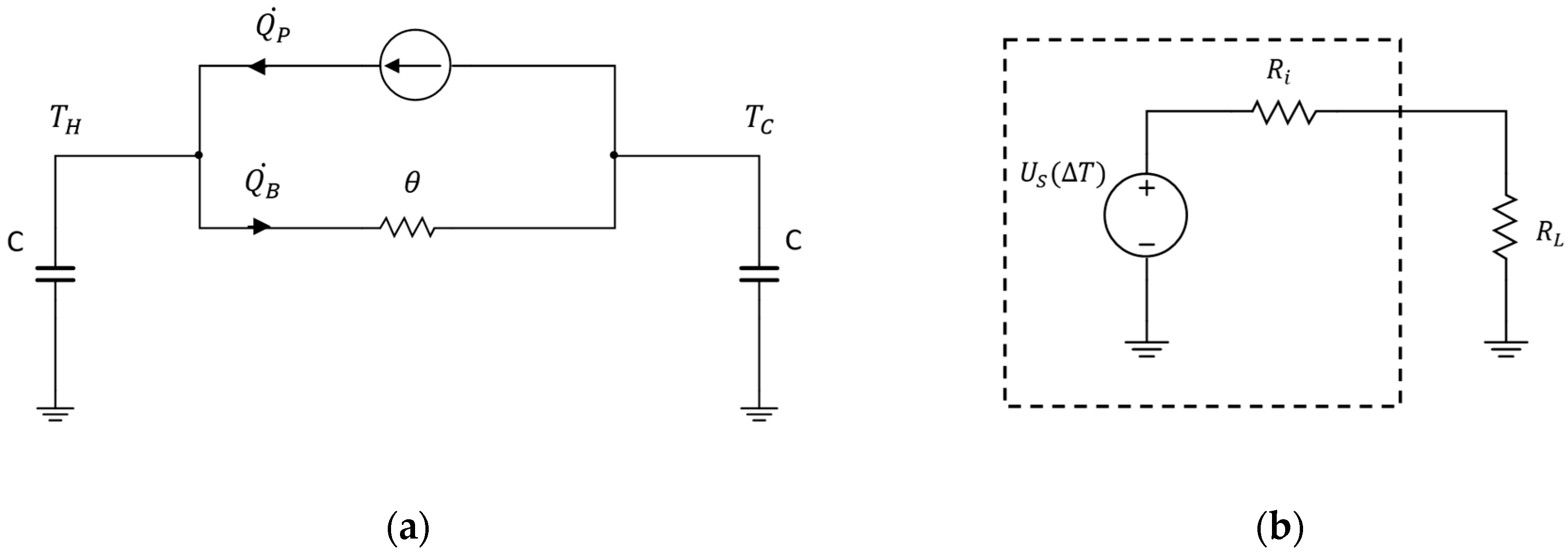

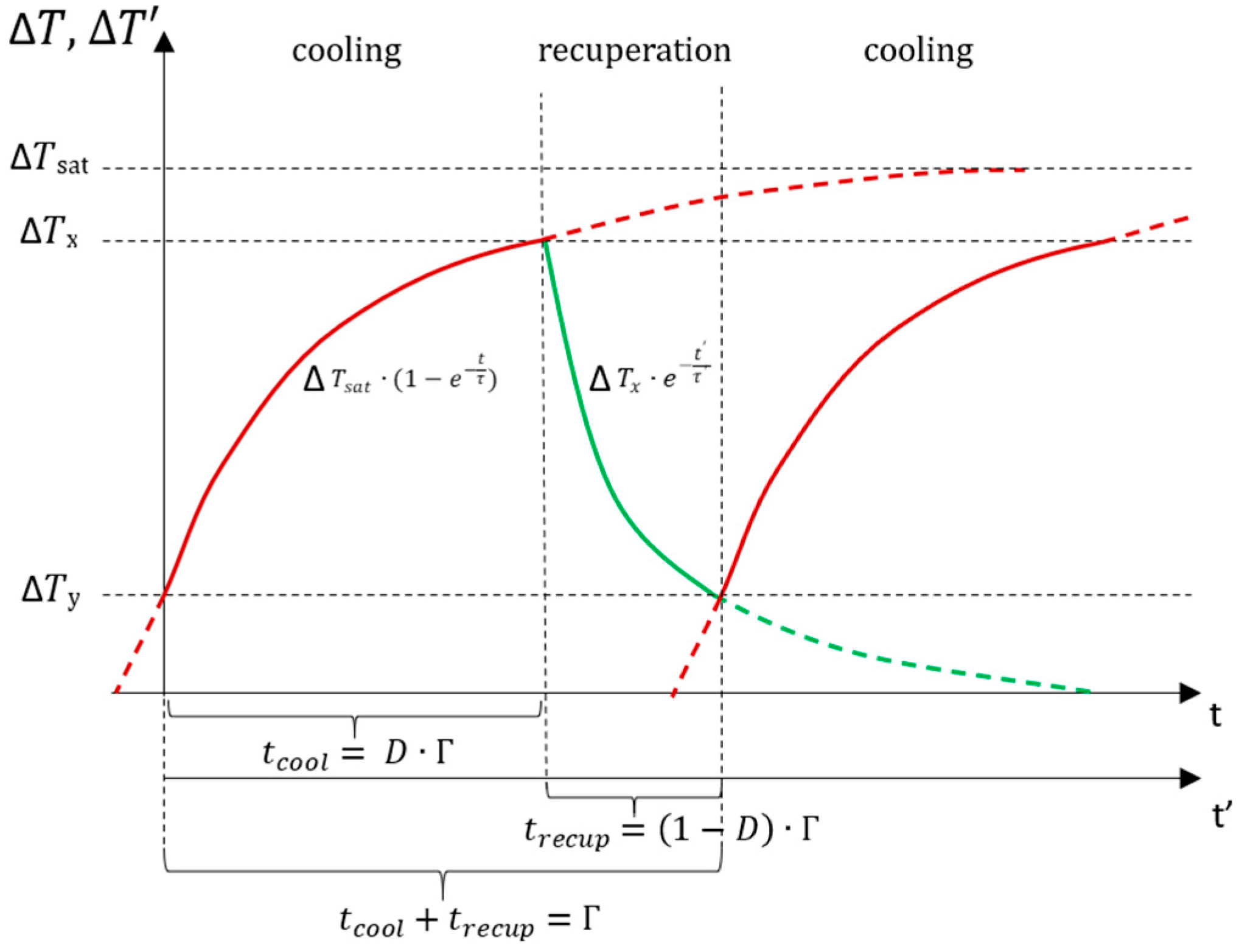
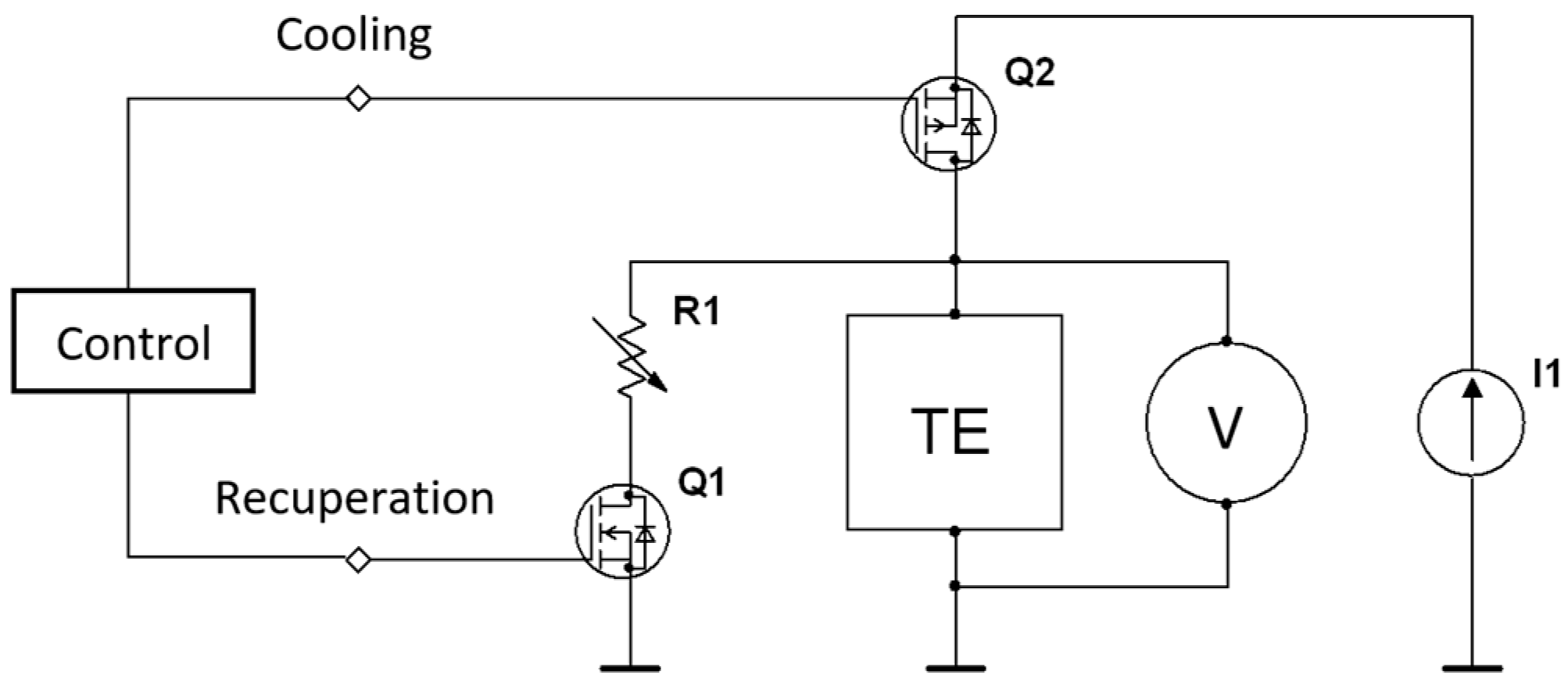
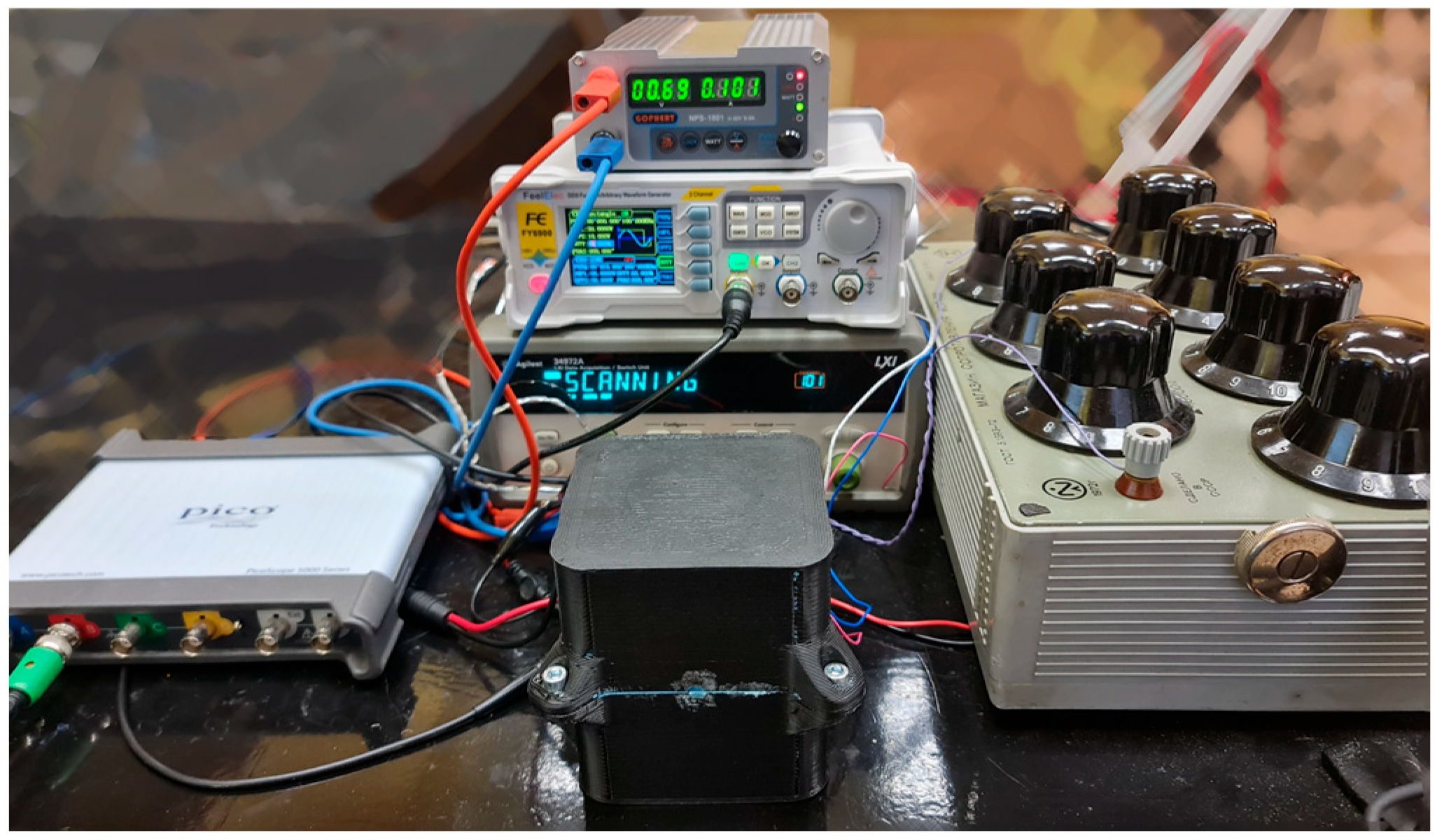


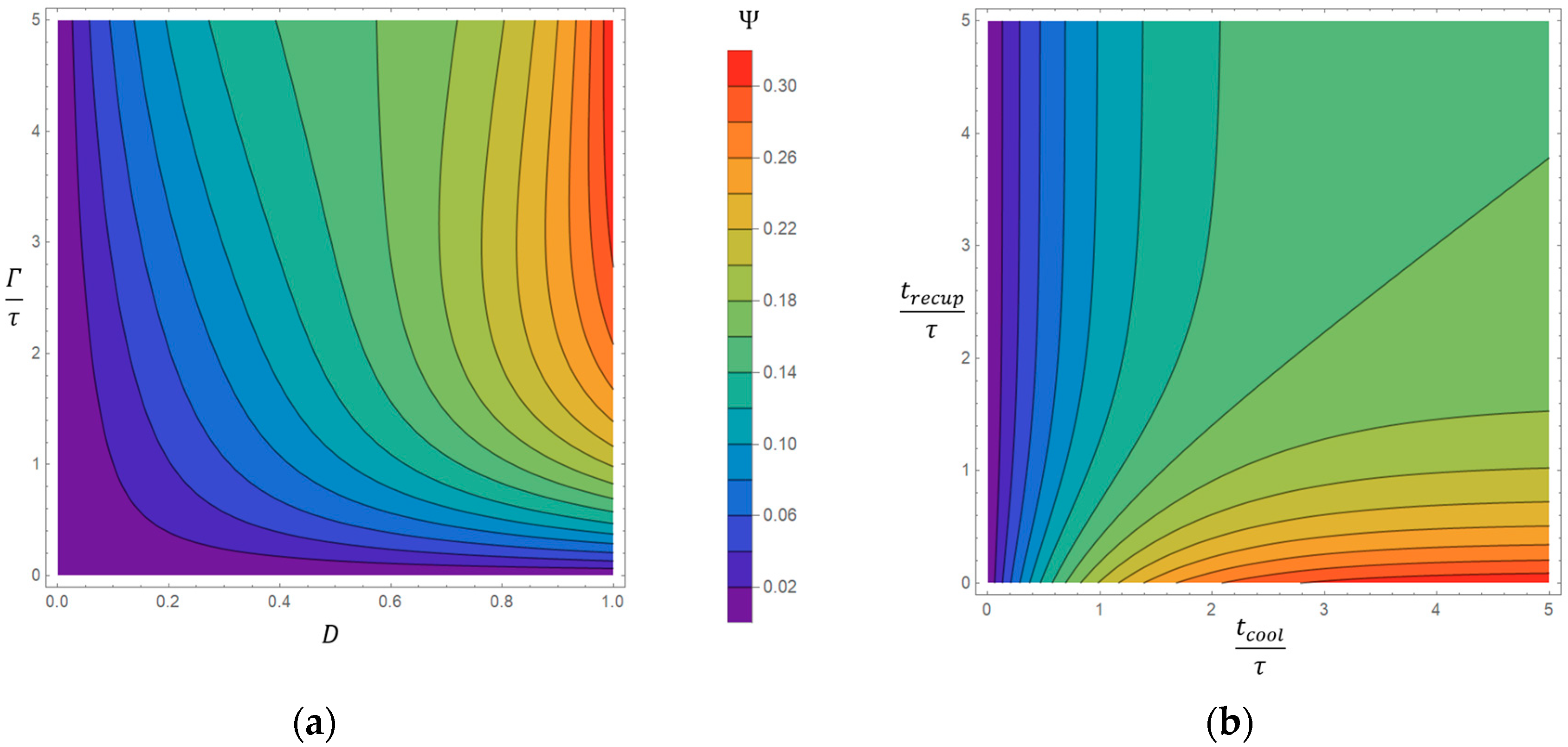
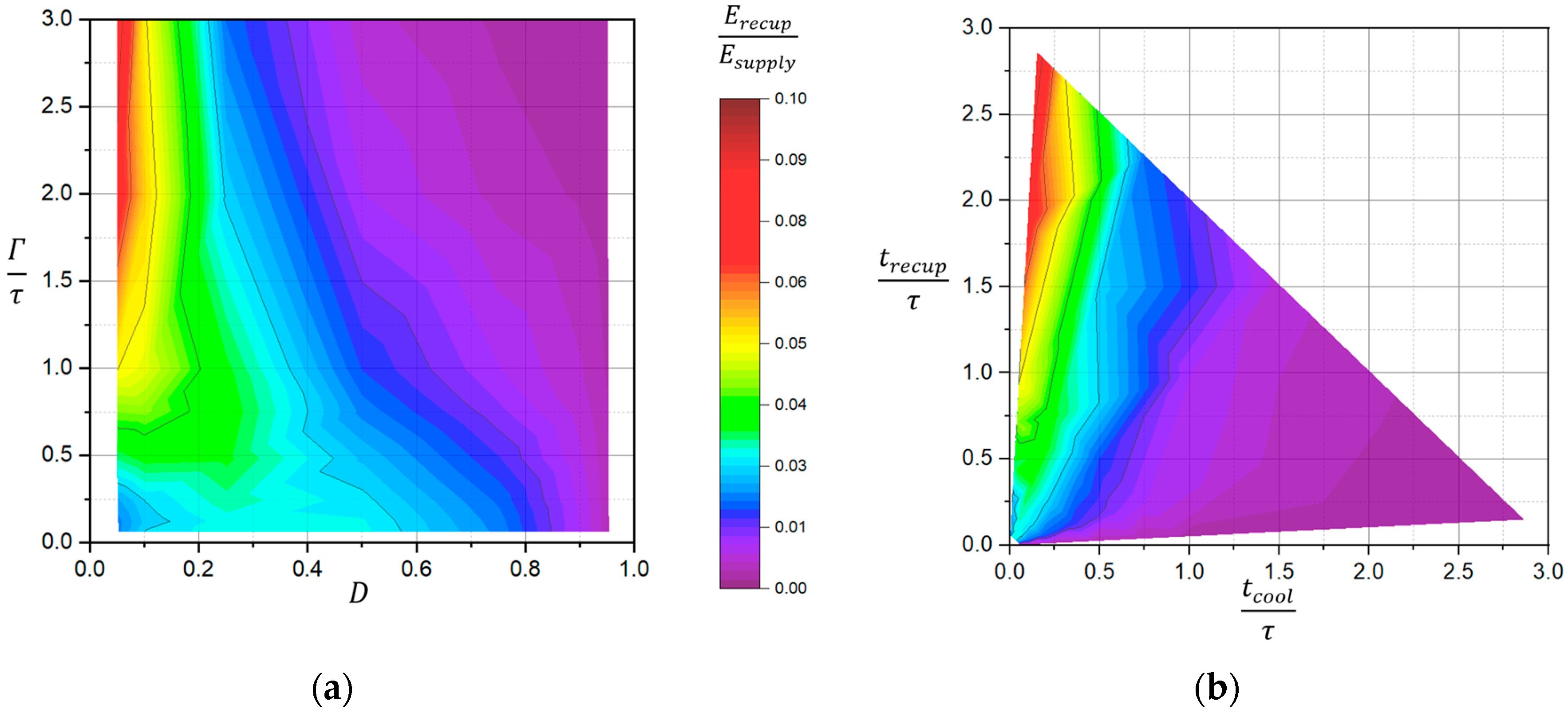

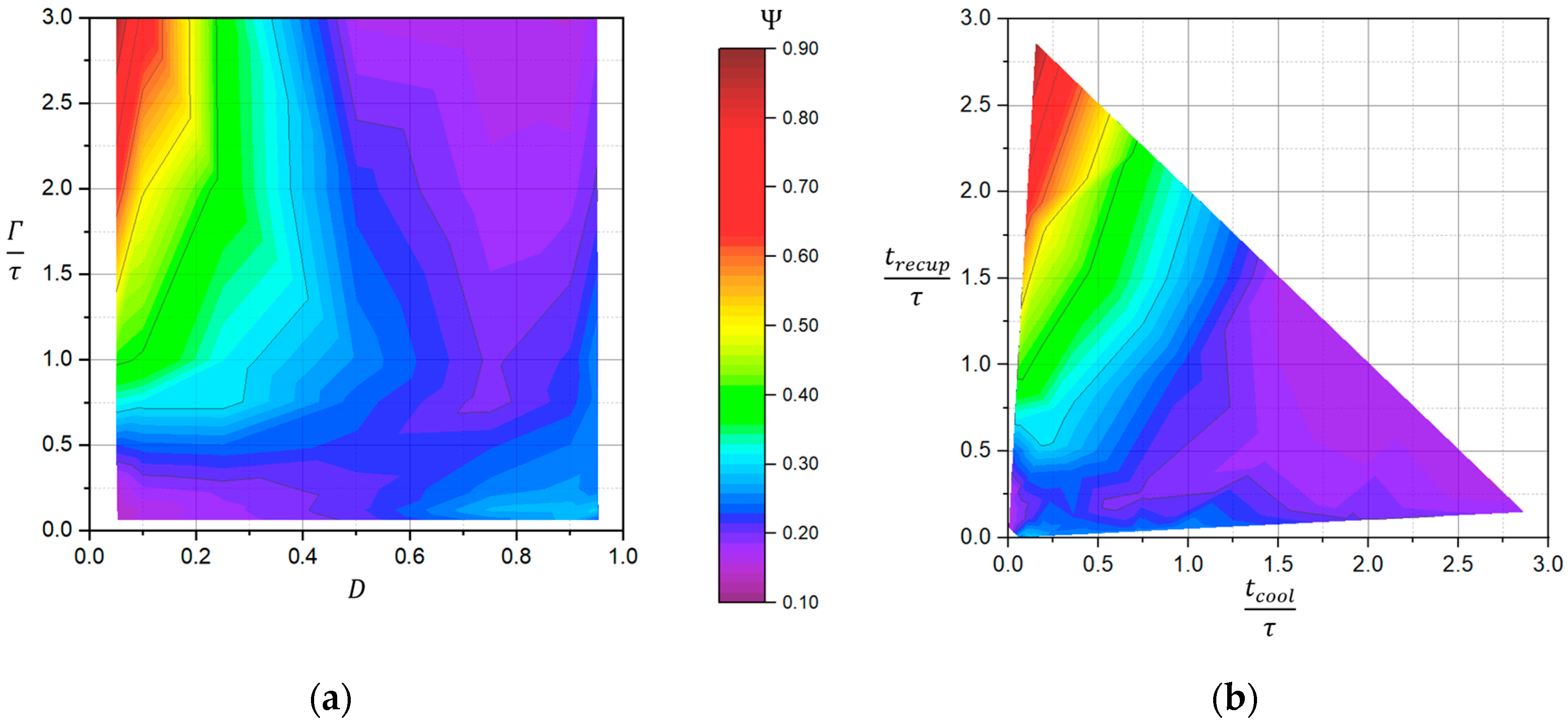
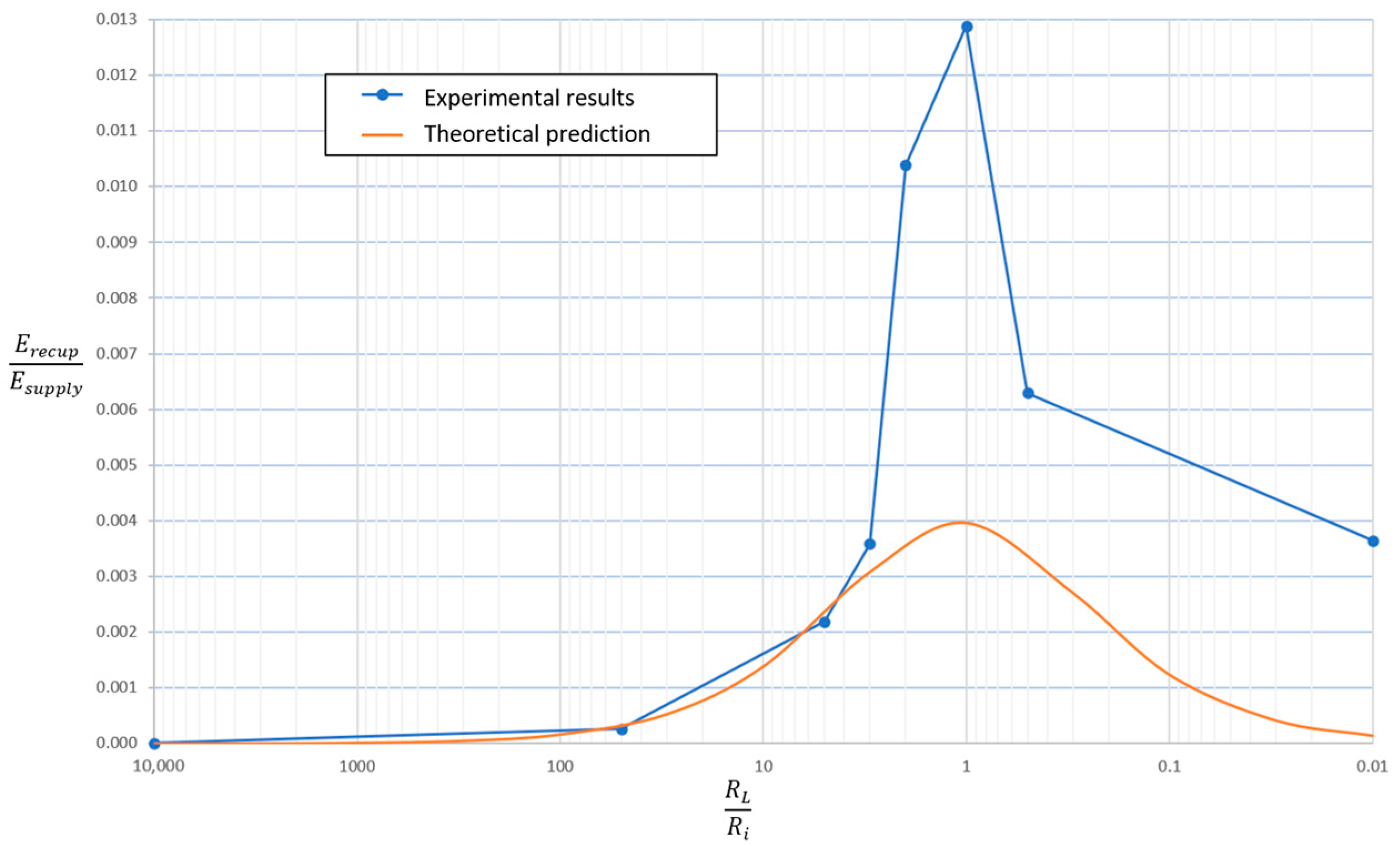


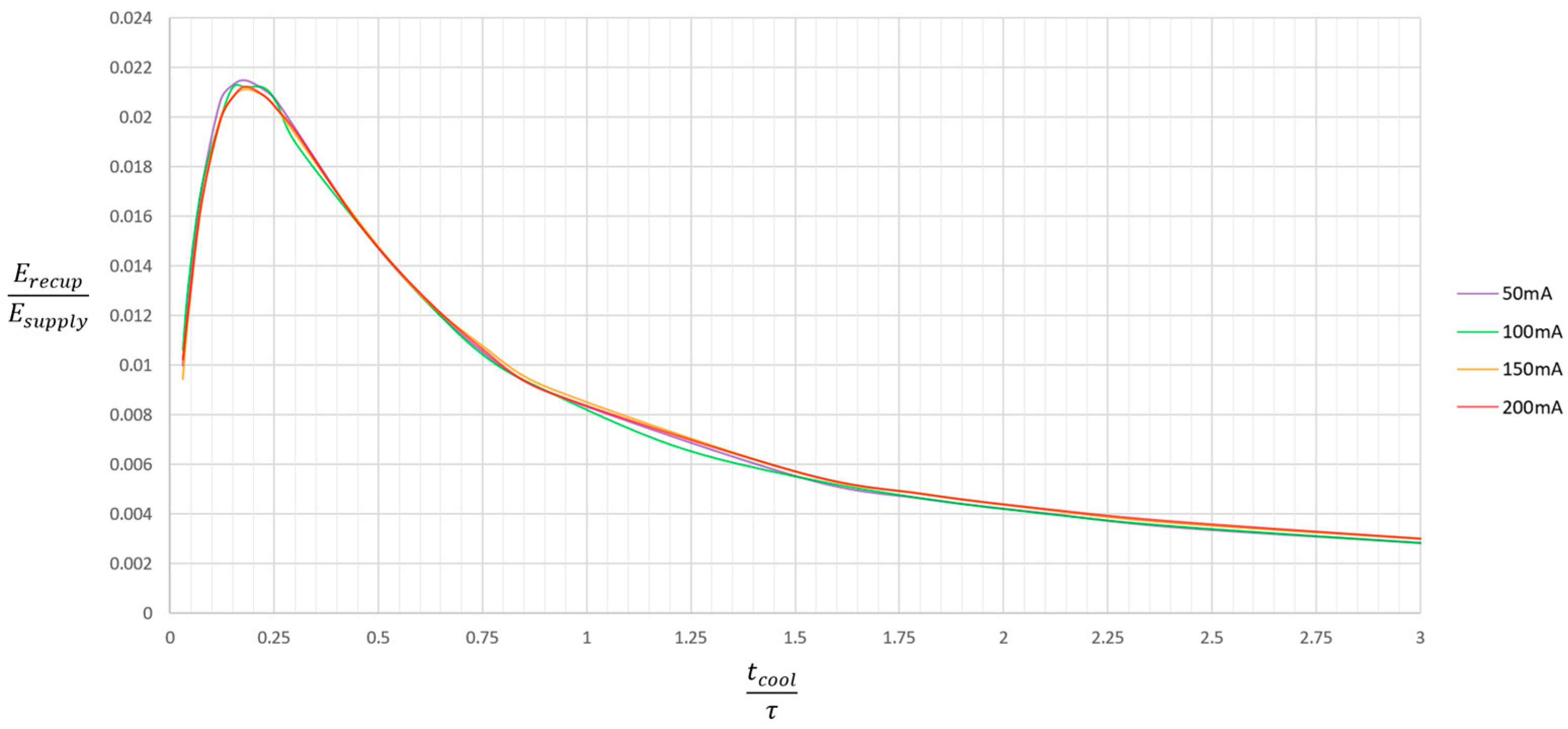
Disclaimer/Publisher’s Note: The statements, opinions and data contained in all publications are solely those of the individual author(s) and contributor(s) and not of MDPI and/or the editor(s). MDPI and/or the editor(s) disclaim responsibility for any injury to people or property resulting from any ideas, methods, instructions or products referred to in the content. |
© 2024 by the authors. Licensee MDPI, Basel, Switzerland. This article is an open access article distributed under the terms and conditions of the Creative Commons Attribution (CC BY) license (https://creativecommons.org/licenses/by/4.0/).
Share and Cite
Jurķāns, V.; Blūms, J. Estimating the Impact of a Recuperative Approach on the Efficiency of Thermoelectric Cooling. Sustainability 2024, 16, 5206. https://doi.org/10.3390/su16125206
Jurķāns V, Blūms J. Estimating the Impact of a Recuperative Approach on the Efficiency of Thermoelectric Cooling. Sustainability. 2024; 16(12):5206. https://doi.org/10.3390/su16125206
Chicago/Turabian StyleJurķāns, Vilnis, and Juris Blūms. 2024. "Estimating the Impact of a Recuperative Approach on the Efficiency of Thermoelectric Cooling" Sustainability 16, no. 12: 5206. https://doi.org/10.3390/su16125206
APA StyleJurķāns, V., & Blūms, J. (2024). Estimating the Impact of a Recuperative Approach on the Efficiency of Thermoelectric Cooling. Sustainability, 16(12), 5206. https://doi.org/10.3390/su16125206





